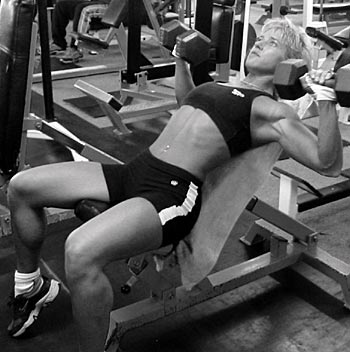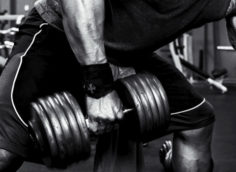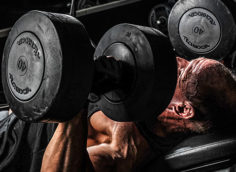In my previous "Violent Variations" article, I gave you a few new ways to bombard your muscles. In order to survive, your muscles would have to grow...or die! Okay, I'm being overly dramatic but you get the point–exercise variation is necessary for continuous growth.
The first instalment of this series addressed biceps, upper back, traps, hamstrings and shoulders. Just when you thought that the pain would subside, here it comes again as I present some killer exercises to blast your quads, triceps and chest.
Think you're ready?
Chest
Ever since the 70's, a big chest has been associated with strength. While a thick back commands respect and big arms are always impressive in a tight shirt, no muscle carries quite the mystique that the pectoral muscles do. Sadly, few peoples are blessed with a genetically solid chest. For most of us, a well developed armor-plated chest can only come from gut wrenching effort in the gym. And if effort and pain is part of your gym time, you'll be well served by these powerful chest bursting exercises!
Blitzkrieg Triple Dumbbell Press
This might just be the most complete and effective way to train your chest. It will thoroughly stimulate most of the muscle fibers of the pectorals, causing them to grow out of proportion at an alarming rate! Sound good? Wait until you've tried it to thank me, the effectiveness of the exercise comes with a price to pay: pain!
This drill is really a combination of three exercises:
- High incline dumbbell press
- Low incline dumbbell press
- Flat dumbbell press
All three are performed as one set, using the same weight. You first perform high incline dumbbell presses until you reach muscle failure. Then you rapidly adjust the bench to a low incline and continue to perform reps until failure. You once again adjust the bench, this time a flat bench position, and still continue to perform more reps. This is one set. This is a very intense method. For most people, 2-3 such sets will be more than enough. Do not use this powerful technique too frequently as it's tremendously stressful on the body (which is why it's so effective).
Note that you can perform the same drill but with dumbbell flies instead of presses. I, however, prefer the press version as the fly version tends to be hard on the shoulders.
Casualties of War 1-arm Dumbbell Press
While I'm listing this one as a chest exercise, it could also be included in a list of powerful abdominal drills. It requires intense abdominal wall bracing to execute the movement properly.
The exercise is basically a flat dumbbell press, but with two modifications:
- You perform the drill one arm at a time.
- Only half of your body (opposite side of the working arm) is on the bench.
The trick is to focus on keeping the torso perfectly straight; do not let it drop down toward the floor during the eccentric portion of the lift. Contract your abs very hard during the entire movement to stabilize the trunk.
Lower the dumbbell while stretching the pectorals, meaning that you lower the bell more toward your head than your chest (refer to the picture for a clearer explanation).
This drill is best performed slowly to place an important burden on the abdominal wall. You should also use a full range of motion. As you become better at the movement–and more stable–you can increase the speed of the concentric (lifting) portion of the lift while maintaining a slow eccentric (lowering) portion.
Kamikaze Combo Dumbbell Press
This is yet another combo exercise; you lift the dumbbells with a hammer grip, elbows close to your body, and you lower them with the elbows out. Basically we're placing the shoulder girdle in a mechanically advantageous position during the concentric portion of the lift and in a mechanically disadvantageous position during the eccentric portion of the lift. Since you're stronger eccentrically than concentrically, this is a technique that allows you to place a maximum growth stimulus on the muscles during both phases of the lift.
Quads
Muscular arms are a dime a dozen in most gyms around the world. However, how many trainees do you see with really muscular legs? Not many, I bet! To me, leg size and muscularity is a true indication of the character of the individual carrying the tree trunks! There isn't much merit in training biceps, shoulders, and chest. Those are fun to train! However, show me a guy who busts his behind working his legs and I'll show you a hard worker. Obviously no movement can replace the good old back squat when it comes to building massive thighs but a few good exercises can be added to your program to go the extra mile, so to speak.
Deadman Quad Raises
This drill is the equivalent of the natural glute-ham raise for the quadriceps. While it seems deceptively easy at first glance, it can really burn those quads of yours when performed properly, leaving you limping for quite some time!
Start on your knees, with the trunk upright and in line with the upper legs. During the whole movement the trunk and upper thighs must be kept on the same line, this is the key to the effectiveness of this drill.
You're going to lower yourself backward (bringing your back toward your feet) under control while remembering to keep your trunk tight in line with the upper legs during the whole movement. You'll lower yourself as low as you can, then you bring yourself back up to the starting position by tensing your quads intensely.
At first you won't need to add any weight to make this exercise hard. As you progress, you can hold a weight plate on your chest to increase the difficulty.
I find this exercise to be especially effective when supersetted with a heavy quadriceps movement like a full back squat or front squat.
Torture Iso 1-leg Squat
This exercise is a lesson in pain tolerance! Just like the preceding drill, it seems simple and relatively easy. However, it can leave the bravest gym rat begging for mercy!
You place your back leg on an elevated object (block or bench). The front leg is brought forward. You bend your front leg at the knee so that the upper leg is parallel to the floor with the knee in line with the front foot. Your trunk should be kept upright with hands on your hips.
The objective is to hold that position for 60 seconds per leg. If you can handle that length of time, you can hold dumbbells in your hands. Don't worry if you can't do it for the whole 60 seconds at first; gradually build up to it.
This exercise is also very effective if used as part of a superset with a basic quadriceps movement; just make sure to do the heavy basic exercise first.
Triceps
By now you should know that the triceps make up more than half of your upper arms' size. In fact, it's closer to 2/3 of it. So if you want big arms, you must work hard on your triceps. Doing hard biceps work will bring you up to a certain level, but to reach sleeve-stretching proportions, lots of triceps work is an absolute must. Furthermore, the triceps play a huge role in many compound movements, including the bench press (in which they are often the limiting factor). Building up those triceps is thus one of the fastest ways to improve your lifting prowess!
Mind Altering Decline Triceps Extensions
A little known fact is that you can recruit up to 10% more muscle fibers during decline triceps work than during regular lying triceps work; at least that's what iEMG studies tell us. In fact, among all the triceps exercises, the decline dumbbell triceps extension is the one that shows the greatest muscle activity.
Dumbbells seem to be superior to a barbell when it comes to working the triceps, but a decline barbell triceps extension will still be a very effective variation, so you can rotate between dumbbells and a bar every 3-weeks or so to maximize gains.
This exercise is pretty straight-forward: you lie down on a decline bench (or use a block to elevate a flat bench) and perform a regular triceps extension with a hammer grip (palms facing each other). Make sure that the upper arm is kept perpendicular to the ground at all times (your elbows should be pointing to the ceiling). It's only the lower arm that moves. Emphasize a full range of motion and a slow eccentric phase to maximize the efficacy of this great exercise.
Gun Turret Rotating Triceps Extensions
This is a fantastic variation of the dumbbell triceps extension to really stimulate all three portions of the elbow extensors. It can be performed on either a decline or flat bench. As I already explained, the decline version might be more effective. However, even the best exercise stops being effective at some point, so having a few variations can't hurt.
This drill is much like your basic triceps extension; however the position of the upper arm changes during the movement. You start (top position) with the thumbs facing each other. As you go down you rotate your upper arms inward. At the mid-range point of the movement your palms should be facing each other and in the bottom position the pinkie fingers should be facing each other.
You execute the concentric portion of the lift using the reverse action (outward rotation). To get the most out of this exercise I suggest using a slow tempo during the entire movement: lowering it in 5 seconds and lifting it in 3 seconds is ideal.
Conclusion
By now I'm sure that you're just dying to get into the gym to try some of these new exercises (ironically, you might just die doing them!). Hopefully these first two parts will enable you to spark some growth by injecting some new blood into your program. In part 3 of this series I'll discuss other painful training methods that will help you take your muscle gains to new heights!
Stay tuned.













